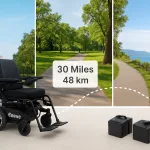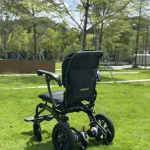When choosing an electric wheelchair, braking systems are a critical safety feature to consider. Two common types of braking systems used in electric wheelchairs are electromagnetic brakes and mechanical brakes. Understanding the differences between them can help you make an informed decision that suits your lifestyle and mobility needs.
1. How They Work
Electromagnetic Brakes
Electromagnetic brakes are automatically engaged when the wheelchair is not moving. They use an electric current to hold the brake pads against a motor shaft. When the user activates the joystick or controller, the current releases the brake, allowing the chair to move.
Mechanical Brakes
Mechanical brakes function manually. They typically involve a lever that engages a brake pad against the wheels or axles, similar to a bicycle brake. Some power wheelchairs may use them as an emergency or backup system.
2. Key Differences
| Feature | Electromagnetic Brakes | Mechanical Brakes |
|---|---|---|
| Control | Automatic (no user action needed) | Manual (requires user input) |
| Safety | Automatically locks when stopped or powered off | May not engage automatically |
| Ease of Use | Very easy, no physical effort | Requires strength and reach |
| Maintenance | Less frequent but may need professional service | Simple, but requires regular checks |
| Reliability in Power Loss | Stays locked when power is off | May not work if not manually applied |
3. Advantages of Electromagnetic Brakes
- Hands-free operation: No need to engage or disengage manually.
- Automatic safety: Chair stops and locks automatically when you let go of the joystick.
- Ideal for inclines: Prevents rolling backwards on slopes.
4. Advantages of Mechanical Brakes
- Simple mechanics: Easier to understand and maintain for those with some technical knowledge.
- Backup option: Useful if the electronic system fails.
- Cost-effective: Generally cheaper than electromagnetic systems.
Which One Should You Choose?
If you prioritize ease of use, safety, and automation, especially for outdoor or uneven terrain use, electromagnetic brakes are typically the better option. They are standard in most modern electric wheelchairs, including advanced models like the EASWE A10 and B10.
However, if you want a basic, cost-effective system or a backup option, mechanical brakes may be sufficient—especially for lightweight transport chairs.
Conclusion
Both systems have their pros and cons. The right choice depends on your mobility needs, strength, and how you plan to use your wheelchair. When in doubt, consult with your wheelchair provider or a mobility specialist to find the best fit.





















